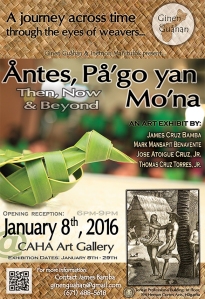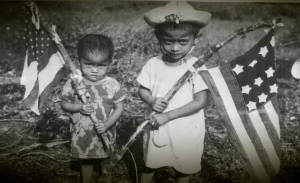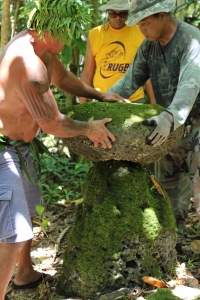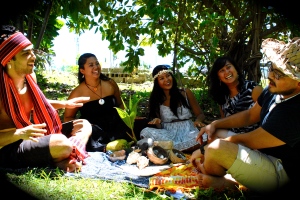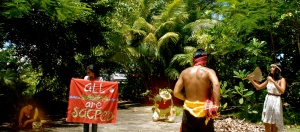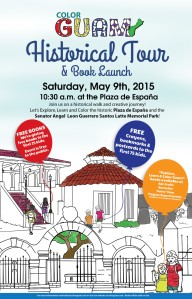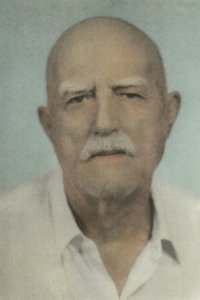By Samantha Marley Barnett
In October 2017, I traveled to New York City to speak in front of the United Nations about the United States military contamination and colonization of Guam. The trip was organized by Independent Guahan, a local group which advocates for our island’s future as an independent nation. I spoke at the UN on behalf of Prutehi Litekyan, a direct action group dedicated to the protection of natural and cultural resources in all sites identified for the US Department of Defense live-fire training ranges on Guam.
Chamorros have been testifying at the UN since 1982, when members of a group called the Organization of People for Indigenous Rights first appealed to the international body. There are many parallels between this groundbreaking effort and the most recent trip to the UN, including parallels between the island’s political climate in both 2017 and 1982 and the threats to Chamorro rights and cultural heritage that sparked the efforts.
For more information on the role that the UN has played in Guam’s decolonization movement over time, check out the Guampedia entry here.
In 1982, Chamorros rights activists formed a group called OPI-R (Organization of People for Indigenous Rights). OPI-R reached out to the community through fundraising efforts and successfully sent representatives Robert Underwood, Chris Perez Howard and Teehan to the UN to petition on behalf of Guam and the rights of the Chamorro people.
In his testimony, Underwood described the history of colonization in the Marianas and the urgent need for Chamorro self-determination. He explained that the right to self-determination belongs exclusively to the Chamorro people, because Chamorros have historically been denied the ability to speak for themselves and determine their political destiny. He also stated that it’s unfair to allow non-Chamorro residents of Guam to participate in a vote that would determine the island’s political status while the Chamorros themselves have yet to have a say in the future of their homeland. You can read the rest of Underwood’s testimony here.
Today, Guam’s journey to decolonization faces many of the same roadblocks that Underwood and other members of OPI-R spoke out against. Recently, a white resident of Guam argued that the Guam decolonization registry, which was only open to native Chamorros, is discriminatory and that any future political status vote should be open to all residents of the island, and not just the Indigenous people. The District Court of Guam ruled in Davis’ favor. Chamorros have yet to determine their political future, yet the US military build-up continues on island and sites that are sacred to the Chamorro people are being contaminated and disrespected.
In 2017, Independent Guahan launched a community fundraising effort and raised enough money to send several delegates to represent the rights of the Chamorro people at the UN, just as OPI-R had done in the past.
As for my story, I testified in front of the UN because I have listened to the stories of my elders and witnessed how they survived the violence of land theft, wartime violence, and colonial education which robbed them of their language and self-worth. I testified because during that previous summer, the island was consumed by media announcing North Korea’s threat to bomb our island. During that time, my five year old brother asked me if my baby sister will get to grow up if our island is bombed.
That same day, I was working with a local senator to help World War II survivors complete war reparations forms. One elder told me that as a child during the Japanese occupation of Guam, he watched a Japanese soldier beat his mother with a bamboo stick until the stick was broken by the force of his blows. He said his mother held onto her strength and her pain and refused to cry in front of the soldier. He explained that only later, while he watched his mother show her bloodied back to her sister that she realized his mother’s pain, her determination to survive. It is because this mother did not scream then that I believe it is my responsibility to speak out against war, and Guam’s use as a military pawn. As a daughter of her island, I believe that I have inherited her resilience and I will not be silent.
In my testimony, I explained that the US Department of Defense is currently planning to move forward with the construction of a massive live firing training range complex overlooking the sacred village of Litekyan, where the Chamorro people have been thriving for over 3,5000 years.
According to the Navy’s estimates, more than 79 ancestral and historical sites on land and in the ocean will be bulldozed or adversely impacted at or near Northwest Field and Litekyan. The firing range also presents a huge threat to our main source of drinking water: 6.7 million bullets will be fired at Litekyan each year–bullets containing lead and other toxics, above our primary aquifer that supplies 80-90 percent of our island’s drinking water.
The 2017 Guam delegation was historic because while we were joined by several of our elected leaders, the majority of the delegation was composed of young Chamorros. Most of us were in our early twenties, and have been mentored and inspired by the previous generations of Chamorro rights activists. It is empowering to see how the older generations have guided us and continue to support the growth and voices of Guam’s youth.
As a student of Guam history, I believe that the most beautiful things come from struggle, and the strength and resilience of Chamorro people is a testament to this.
Stay updated on the work of the United Nations by visiting the Fourth (Special Political Decolonization) Committee of the General Assembly website. For information on opportunities to get involved with efforts to testify at the UN, contact Guampedia!

